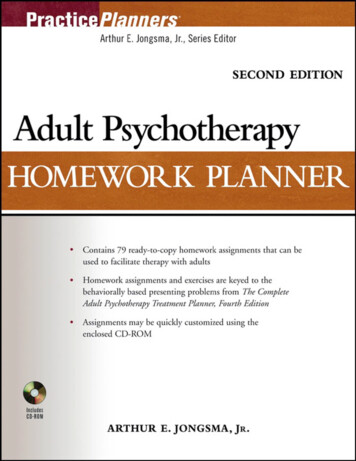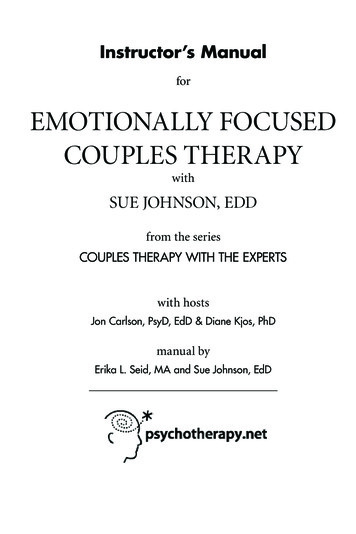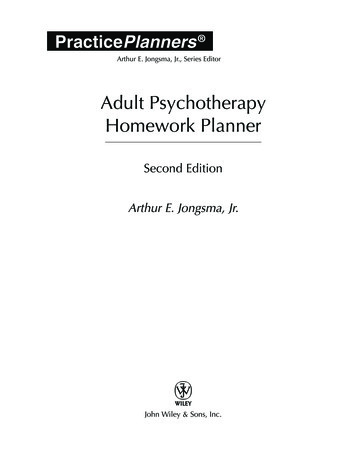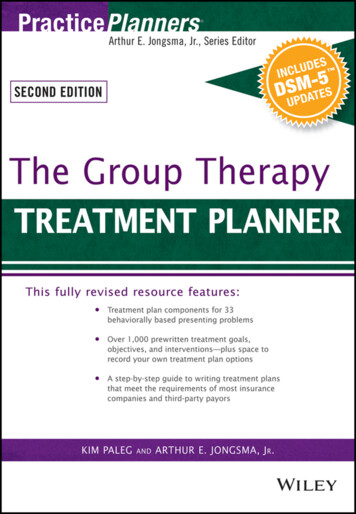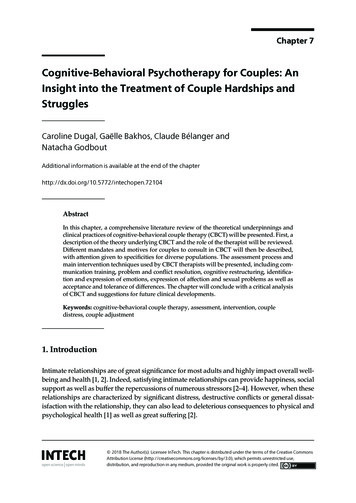
Transcription
DOI: 10.5772/intechopen.72104Provisional chapterChapter 7Cognitive-Behavioral Psychotherapy for Couples: AnInsight into the Treatmentof Couple uples:AnStrugglesInsightinto the Treatment of Couple Hardships andStrugglesCaroline Dugal, Gaëlle Bakhos, Claude Bélanger andNatacha Dugal,GodboutCarolineGaëlle Bakhos, Claude Bélanger andNatachaGodboutAdditional information is available at the end of the chapterAdditional information is available at the end of the bstractIn this chapter, a comprehensive literature review of the theoretical underpinnings andclinical practices of cognitive-behavioral couple therapy (CBCT) will be presented. First, adescription of the theory underlying CBCT and the role of the therapist will be reviewed.Different mandates and motives for couples to consult in CBCT will then be described,with attention given to specificities for diverse populations. The assessment process andmain intervention techniques used by CBCT therapists will be presented, including communication training, problem and conflict resolution, cognitive restructuring, identification and expression of emotions, expression of affection and sexual problems as well asacceptance and tolerance of differences. The chapter will conclude with a critical analysisof CBCT and suggestions for future clinical developments.Keywords: cognitive-behavioral couple therapy, assessment, intervention, coupledistress, couple adjustment1. IntroductionIntimate relationships are of great significance for most adults and highly impact overall wellbeing and health [1, 2]. Indeed, satisfying intimate relationships can provide happiness, socialsupport as well as buffer the repercussions of numerous stressors [2–4]. However, when theserelationships are characterized by significant distress, destructive conflicts or general dissatisfaction with the relationship, they can also lead to deleterious consequences to physical andpsychological health [1] as well as great suffering [2]. 2016 The Author(s). Licensee InTech. This chapter is distributed under the terms of the Creative Commons 2018 TheAuthor(s).Licensee InTech. This chapter is distributedwhichunderpermitsthe termsof the ommons.org/licenses/by/3.0),unrestricteduse, mons.org/licenses/by/3.0),whichpermits unrestricted use,andreproductionin anymedium, provided the original work is properlycited.distribution, and reproduction in any medium, provided the original work is properly cited.
118Cognitive Behavioral Therapy and Clinical ApplicationsCognitive-behavioral couple therapy (CBCT) aims at assisting romantic partners who reportdistress in their relationship. Over the years, CBCT has been extensively evaluated in treatment outcome studies, which have repeatedly concluded in its effectiveness for decreasingcouple distress and dissatisfaction as well as for addressing communication or problem-solving difficulties [5–7]. Studies have also found that such improvements seem to be maintainedfor up to 2 years by most couples [8].In this chapter, a comprehensive literature review of the theoretical underpinnings andclinical practices of CBCT will be presented. First, a description of the theory underlyingCBCT and the role of CBCT therapists will be offered. Possible mandates and motives forconsulting in CBCT will then be described, with particular attention to the specificities inCBCT for diverse populations. The assessment process used in CBCT will also be addressed,allowing readers to understand the particularities of psychotherapeutic work with couples.Subsequently, the main intervention techniques used in CBCT will be defined: communication training, problem and conflict resolution, cognitive restructuring, identification andexpression of emotions, expression of affection and sexual problems as well as acceptanceand tolerance of differences. The chapter will conclude with a critical analysis of CBCT andsuggestions for future clinical developments.2. A brief history of the theoretical underpinnings and objectives ofCBCTThe origins of CBCT stem mainly from Stuart’s [9] work on behavioral exchanges betweenpartners. He based his analysis of couple interactions on learning principles [10] and socialexchange theory [11], postulating that individuals’ evaluation of their relationships woulddepend on the ratio of benefits to costs, resulting from positive and negative exchanges withothers. Stuart [9] thus proposed a behavioral exchanges paradigm where successful relationships could be differentiated from dysfunctional ones by the frequency of positive and negative behavioral exchanges. Positive behaviors include constructive problem solving as well asempathically expressing and listening to each other, whereas negative behaviors refer to theexpression of criticism, hostility, contempt or withdrawal from interactions with the partner.Early behavioral couple therapies [12, 13] focused primarily on behavior changes and theacquisition of skills aimed at increasing the frequency of positive behaviors and reducingaversive behavioral interactions through the development of effective communication andproblem-solving strategies [14].During the last decades, behavioral couple therapy expanded by including interventions thatalso addressed emotions and cognitions contributing to conflicts and dissatisfaction. This wasachieved by highlighting the importance of attributions, dysfunctional beliefs and distortedcognitions in romantic partners’ evaluation of their relationship [15]. For instance, by selectively attending to specific behaviors or characteristics in the partner or by approaching thepartner with expectations or standards about how he or she should be or act, individuals will
Cognitive-Behavioral Psychotherapy for Couples: An Insight into the Treatment of Couple http://dx.doi.org/10.5772/intechopen.72104see variations in their appreciation of their partner and of their relationship. Cognitions alsodepict the way partners process information originating from the others’ behaviors, whichguide their interpretation of events as well as expectations towards the other and the relationship [15].Work from Jacobson and Christensen [16] increased focus on acceptance strategies as away to help partners recognize that they are different and eventually learn to respond constructively to difficulties or incompatibilities within the relationship. In 2002, Epstein andBaucom further enhanced CBCT by including work on partners’ needs for intimacy andincreased attention to emotions, not only as a result of modifications in the dysfunctionalbehaviors but also as a primary target of therapy. According to these authors, emotionscan significantly impact relationships through various means: in their expression, throughtheir impact on the interpretations (cognitions) made as well as by affecting behaviorsexpressed towards the other. Epstein and Baucom [17] also emphasized the importanceof considering partners’ vulnerabilities and the impact of the couple’s environment aspart of the multiple factors that can alter partners’ cognitions, emotional responses andbehaviors.A specificity of CBCT lies in its dynamic understanding that cognitions can influence intimate relationships through each partner’s interpretations or appraisals of stressors and oftheir partner’s behaviors [3]. Moreover, the interpretations partners make about the behaviors of the other will determine the positive and negative emotions experienced towards theother. As shown in Figure 1, these emotions are considered to influence future cognitions andbehaviors [14]. As such, in CBCT, behaviors, cognitions and emotions are observed as interrelated and equally important in relationship functioning [18].In summary, the main objective of CBCT is to help couples understand their difficulties inorder to enhance their relational well-being by identifying and challenging the processes atplay in partners’ interactions while taking into account the external factors that can affectthem. To do so, CBCT not only relies on behavioral interventions in the treatment of coupledifficulties, but also emphasizes the importance of working on various cognitive, emotionaland environmental factors that affect a couple’s functioning [18]. CBCT interventions alsoaim at helping couples identify, regulate and express intense or negative emotions when theyarise in and out of sessions. By doing so, CBCT therapists help couples develop their abilityto observe and change their automatic thoughts, assumptions and standards as well as identify the impact that their ways of behaving, thinking, interpreting and feeling have on theirrelationship [3].Figure 1. Interrelations of behaviors, cognitions and emotions in cognitive-behavioral couple therapy.119
120Cognitive Behavioral Therapy and Clinical Applications3. The role of CBCT therapistsCBCT therapists hold different roles that will vary depending on the stage of therapy andthe needs of clients [19]. For instance, during the first sessions of CBCT, the therapist typically uses psychoeducation to inform clients about the approach and related interventionand acts as a facilitator by creating a safe and supporting environment where emotionsor concerns may be expressed freely. He/she will also act as a collaborator to develop thetreatment goals. However, a more directive approach will also be used by CBCT therapists to address dysfunctional interactions or the escalation of conflicts in order to createand preserve a safe environment for therapy and help partners understand what is goingon and learn new ways of dealing with their disagreements [20]. A directive approachmight also be needed to deal with crisis interventions (see Section 4.4). Throughout sessions, CBCT therapists can also take a more didactic role, for instance, when they teachcommunication and problem-solving skills for couples [12]. They will also act as guideswhen they help partners identify the interrelations between their cognitions, emotions andbehaviors [17].In CBCT, the therapist undertakes the responsibility of establishing and maintaining thetherapeutic alliance with both partners [19]. In order to lay the foundations for a healthytherapeutic alliance, the therapist is thus expected to swiftly orchestrate sessions by fairlyallocating speaking time for each partner to express themselves [20], while demonstrating neutrality and empathy [21]. If situations occur in which therapists feel unable toremain neutral towards a couple and if it significantly hampers their ability to help partners, they should seek supervision. Special consideration must also be given to the management of secrets between one partner and the therapist, for instance, in cases whenan ongoing extradyadic affair is admitted by a partner during the individual session ofassessment (see Section 5.2 for the phases of the assessment interviews). In such situations, it is advised that the therapist takes a neutral position by explaining to partnersthat he/she cannot engage in therapy while withholding information that would affectthe process of therapy or bring he/she in collusion with one of the partners against theother [20].4. Possible mandates and motives for consultation in CBCTThe first step a CBCT therapist undertakes is to question partners’ objectives and expectationswith regards to therapy. Poitras-Wright and St-Père [22] have proposed three main therapeutic mandates in couple therapy: alleviation of distress, ambivalence resolution and separation intervention. According to Tremblay and colleagues [23], therapeutic mandates canalso be reliably classified and revised during the course of treatment to take into account thespecific needs of couples which may change over time. The following sections describe howthese different mandates are conducted in CBCT, with an additional section allocated to crisisintervention.
Cognitive-Behavioral Psychotherapy for Couples: An Insight into the Treatment of Couple http://dx.doi.org/10.5772/intechopen.721044.1. Alleviation of distress and relationship improvementOver the years, CBCT has accumulated strong empirical support for its efficiency to alleviaterelationship distress and enhance couple functioning [18]. These therapeutic gains would alsoseem to persist years after the end of treatment [24]. Research has shown that the therapeutic goals couples formulate regarding alleviation of distress revolve around communicationproblems, dissatisfaction with manifestations of emotions and affection, sexual problems,financial problems as well as decision-making or problem-solving issues [25–27]. Since someof these concerns are quite frequent, they are typically addressed with the common CBCTinterventions presented in the fifth section of this chapter. However, many couples also consult for difficulties that require a more distinct approach, some of which include the presenceof conflicts and violence, extradyadic affairs, infertility as well as various psychological orhealth-related problems partners might have.4.1.1. Conflicts and violenceMany couples find it difficult to resolve their conflicts, and this difficulty heavily affectstheir functioning and satisfaction within the relationship [28]. Yet, it is how a couple handlesdisagreements that will determine how satisfied partners are with their relationship [29].Accordingly, unresolved conflicts constitute one of the most frequent consultation motivesfor couple therapy [25]. As such, CBCT offers techniques aiming at the enhancement of positive interaction patterns in couples as well as the improvement of communication and problem-resolution techniques in order to diminish conflicts within couples [30].Conflicts between spouses can also spiral into violence [31], for instance, when partners escalate theirs conflicts to a point where they will resort to psychological or physical violence.Indeed, partner violence is a serious challenge that many couples face but that is frequentlyunder-reported or concealed by partners who may, for example, rather report consulting toaddress difficulties in dealing with conflicts [32]. During the assessment phase of CBCT, thepresence of violence must systematically be assessed in order to decide whether or not CBCTshould be conducted [33]. For instance, when partner violence is severe or perpetrated by onepartner towards the other, couple therapy is usually contraindicated because it could lead tofurther violence. The therapists should then deliver a crisis intervention (see Section 4.4 forcrisis intervention) [32, 33]. On the contrary, when partner violence is situational and minorto moderate and when both partners agree to cease all acts of violence during therapy, CBCTcan be useful in preventing the escalation of conflicts to more severe forms of violence [33,34]. Indeed, a few therapies using a CBCT framework or techniques have been developedto treat moderate intimate partner violence and show promising results in the reduction ofmild-to-moderate violent behaviors [35–38]. Such therapies include interventions that promote positive interactions between partners, assertion and communication skills, increasedimputability in conflicts and an understanding of the escalation of conflicts into violence.These interventions also seek to challenge the cognitive distortions that are entangled in conflicts and to help partners to better control their anger and other negative emotions as well asto help them negotiate time-outs during conflict.121
122Cognitive Behavioral Therapy and Clinical Applications4.1.2. Infidelity/extradyadic affairsInfidelity is a relational problem that many who consult in couple therapy might eventually face [39]. Indeed, studies have shown that from 20 to 40% of couples will experienceinfidelity at least once [40] and 20–57% of men and 14–32% of women will report havinghad an extradyadic affair at least once in their life [41–43]. According to therapists, infidelityrepresents one of the most prevalent and difficult problems to treat in couple therapy [44,45]. This is mainly due to the feelings of betrayal and relationship distress that commonlyresult from extradyadic affairs [46, 47]. This problem is also particularly difficult to address intreatment because it frequently puts partners in a situation where they question their desireto continue their relationship [48, 49]. This being said, many studies have concluded in theeffectiveness of CBCT in the treatment of extradyadic affairs in terms of decreased psychological symptoms of depression and relationship distress [40, 50, 51]. Since CBCT commonlyaddresses infidelity as a form of interpersonal trauma experienced within the intimate relationship [52], interventions for this problem generally aim at dealing with the crisis followingdisclosure of the extradyadic affair and at the exploration of factors that might have contributed to the affair. This will be accomplished by giving the extradyadic affair a meaning[17, 52]. Since this type of couple difficulty tends to take place when the needs of a partner arenot fulfilled in the current relationship [46–48], forgiveness-based interventions can also beused to help partners better understand the circumstances in which infidelity has taken placeand repair the relationship. Partners will then learn how to “reconnect” after having been hurtby the other, to “turn the page” and to move forward [52].4.1.3. InfertilityAccording to Sullivan et al. [53], the number of couples who encounter fertility problems is growing, with an average of 10–15% of couples experienced fertility issues. Importantly, for manycouples, infertility constitutes a major crisis, and even a significant traumatic event that hasimportant repercussions on partners’ individual and relational well-being [54]. Indeed, infertilityas well as the many consequences related to its treatment, such as its cost, its time requirementsand the uncertainty of its results [53, 54], can lead to psychological consequences, especially highlevels of stress [55], depression, low self-esteem, marital and life dissatisfaction [56, 57], sadnessand denial [54] as well as feelings of guilt [54]. Some interventions using CBCT techniques havebeen developed to treat this problem [53, 58] and aim at facilitating disclosure and communication between partners, exploring the meaning and nature of grief (e.g., when partners learn theycannot have children), enhancing the couple’s ability to understand and support each other anddeveloping useful strategies for stress reduction and problem solving related to infertility.4.1.4. Individual problemsIn general, studies have demonstrated that couple-based therapies are effective across a widerange of individual problems and disorders that not only address an individual’s psychological functioning but also his or her partner’s relationship satisfaction. Consequently, CBCT hasalso been customized to treat a plethora of individual difficulties [19]. This approach argues
Cognitive-Behavioral Psychotherapy for Couples: An Insight into the Treatment of Couple http://dx.doi.org/10.5772/intechopen.72104that by including the partner in the treatment of an individual’s difficulties, the latter will benefit from support from his or her partner, which in turn will enhance the couple’s functioningand alleviate personal difficulties [18, 59]. Alcohol use disorder is an example of an individualproblem that is widely recognized as exerting a devastating effect on couple functioning andsatisfaction [60, 61]. Indeed, adults with an alcohol use disorder are four times more at riskof separation and divorce than those who do not present such problems [62]. The perceivedquality of the romantic relationship is also known to modulate the effect of substance useon couple functioning, so that satisfied couples experience less distress caused by substanceabuse than dissatisfied couples [63]. Interestingly, support was found for the use of CBCT toreduce alcohol and drug use disorders as well as increase relationship satisfaction [64, 65]. Forinstance, CBCT for alcohol use disorder, which draws upon cognitive-behavioral methodsfor the treatment of alcohol use disorders [66] and behavioral couple therapy [67], simultaneously aims at decreasing alcohol use and increasing relationship stability and satisfaction [62].The underlying assumption of this therapy is that drinking behaviors might be intertwinedwith the ability to cope with negative couple interactions. As such, by learning new ways tointeract with the partner and by staying abstinent, partners are better able to cope with relationship distress [62].Mood disorders, particularly depression, are also known to have a bidirectional association with couple functioning [68], with lower relationship quality leading to higher depressive symptoms and higher depressive symptoms generating lower relationship quality [69].As such, when depressive symptoms act as risk factors or follow relationship difficulties,couple therapy for depression has been shown to be effective in reducing depressive symptoms and relationship problems [70]. This therapy aims at enhancing positive interactionsbetween partners and diminishing negative interactions as well as improving communicationand problem-solving abilities [71]. Couple-based interventions have also shown encouraging results for the co-occurring treatment of couple distress and bipolar disorder [72], emotion dysregulation [73], post-traumatic stress disorder [74, 75], obsessive-compulsive disorder[76], anxiety disorders [77] as well as anorexia nervosa [78].4.2. Ambivalence resolution mandateSometimes, couples consult in therapy because one or both partners are unsure whether toend the relationship [79]. Drawing from their empirical results, Boisvert and colleagues [25]highlighted that one out of four couples consulting in therapy tend to report such ambivalence. In these situations, CBCT therapists usually suggest an ambivalence resolution mandate in order to help couples take a decision on the future of their relationship [80]. Yet, thismandate is not much addressed in the CBCT literature. Among the few authors offeringclinical guidelines on this topic, Wright and colleagues [14] propose to include the exploration of emotions, beliefs and expectations of each partner regarding the continuation of therelationship, while putting any harsh decisions or behaviors about the relationship on holduntil a final decision is reached by both partners. The therapist then helps partners define anew therapeutic mandate based on their decision, whether it is relationship improvement orseparation.123
124Cognitive Behavioral Therapy and Clinical Applications4.3. Separation mandateWhether it results from a decision taken within the course of treatment or whether it is formulated as a primary therapeutic objective, a separation mandate can be put forward to helppartners accept and deal with separation [81]. Indeed, albeit difficult, separation can generatealleviation of distress in certain couples [79]. According to Lebow [82], the CBCT techniquesused in therapy with a separation mandate usually include psychoeducation on how to dealwith the consequences of the separation as well as feelings towards one another after the separation. Problem-solving techniques and communication training are also often conducted insession to alleviate the possible consequences of the separation for couples with a separationmandate in CBCT.4.4. Crisis interventionAlthough crisis intervention is not a therapeutic mandate per se, it can be required prior toCBCT, for instance, when a partner expresses severe personal difficulties (e.g. manifests asuicidal or homicidal risk), discovers the other has been unfaithful or when severe violenceoccurs within a relationship. It is thus necessary for therapists to be able to identify, assess anddeal with such situations in order to help the couple regain stability and security before conducting any other intervention. To do so, Wright and colleagues [14] have developed guidelines for couple therapists. The first action to be performed is to ensure the safety of eachpartner, and by extension of their children, if applicable. When a suicidal and/or homicidalrisk is present, the same guidelines used in individual psychotherapy are applicable in CBCTwith a particular attention given to the safety of both partners. The therapist must then assesswhether couple therapy should be continued or if individual therapy with a different therapist would be better suited to address these difficulties before starting or resuming CBCT [68,77]. If ongoing severe violence occurs within a relationship and especially when it is perpetrated by one partner towards the other, rather than minor and bidirectional (see the Section4.1.1 on conflicts and violence), couple therapy is usually contraindicated and specific procedures must be undertaken to control aggressive behaviors and protect the victim. Guidelinesfor such situations have been suggested by Lussier and colleagues [32, 36] and by Bélangerand colleagues [33]. After safety has been ensured and the crisis has started to resolve, thetherapist can help couples make sense of this experience and feel validated in their distress,which can potentially strengthen the therapeutic alliance. Only then does the therapist andpartners discuss new therapeutic goals if partners decide to remain in therapy.4.5. Specificities in CBCT for diverse populationsAs of now, there are clinical and research drawbacks regarding how CBCT can be effectivelyoffered to couples who present specificities that can affect how they experience intimate relationships, such as same-sex or intercultural couples [18, 83]. For instance, in the past decade,the number of intercultural couples has increased in North America [84, 85] but these couplesremain understudied [85]. In addition, even if couples from different cultural backgroundsusually experience the same kind of issues than other couples [86, 87], they may also faceunique challenges that require specific attention in CBCT. Indeed, studies have reported that
Cognitive-Behavioral Psychotherapy for Couples: An Insight into the Treatment of Couple tural couples will experience greater difficulties with communication, marital satisfaction and divorce [88, 89]. As such, intercultural couples might need more negotiation skillsthan others to deal with couple issues (e.g., discussing the language(s) spoken at home, religion and rituals that will be practiced by the children, etc.). Furthermore, parenting and disciplinary styles often involve debates in intercultural couples [85]. Exploring and negotiatingthe couples’ cultural differences could thus potentially foster intimacy between partners andpromote a sense of mutual understanding [90].Due to widespread heterosexist standards, many lesbian, gay and bisexual couples experienceprejudice, rejection, discrimination and lack of social support, which can significantly impedecouple satisfaction and functioning [83, 91]. However, research has shown that, in general,same-sex and bisexual couples show more similarities than dissimilarities when compared toheterosexual couples [92] and tend to seek couple therapy for similar reasons [93, 94]. Indeed,most CBCT interventions, such as cognitive restructuring, role playing, assertiveness training, psychoeducation, decision making and negotiation, are used similarly with same-sex,bisexual or heterosexual couples [23]. Communication and problem-solving training can alsobe of significant importance for certain same-sex or bisexual couples who struggle with internalized homophobia (i.e., refers to negative stereotypes, hate, stigma and prejudice abouthomosexuality or bisexuality that a person with same-sex attraction turns inward on him/herself), issues regarding disclosure of sexual orientation, conflicts related to relationships or thedivision of household work and parenting difficulties (for a review, see [83]). Yet, many therapists report difficulties comprehending the unique situations in which same-sex or bisexualpartners live [95] or report a lack of confidence about how to intervene with same-sex andbisexual couples. In addition, many therapists have few opportunities to develop their psychotherapeutic expertise with patients from sexual minorities given that the majority of theirclients are heterosexual [96]. Therapists must therefore possess a good understanding of thechallenges faced by these couples as well as the ability to have a non-discriminatory attitudein order to help their patients overcome prejudice in and out of their relationship [23]. To doso, couple therapists who decide to work with same-sex and bisexual couples should aim atreceiving specific training or supervision to further understand and help these populations.5. Assessment in CBCTBefore conducting CBCT, the couple therapist must inquire on the partners’ expectationsabout therapy, evaluate the level of functioning or distress of the couple as well as the partners’ motivation for staying together and in engaging in a therapeutic process [22]. By doingso, the therapist can determine the form of assistance that can be offered and tailor a treatmentthat will be most beneficial for both partners [2]. The main objective of assessment is to formulate a case conceptualization of the couple. This is accomplished by defining the concernsfor which partners have sought assistance, identifying the individual, dyadic and environmental factors at play in the difficulties reported as well as by discerning the couple’s existingstrengths that might potentially facilitate the therapeutic process [97]. Therapists also aim atunderstanding both partners’ respective goals in therapy and perspectives with rega
Cognitive-Behavioral Psychotherapy for Couples: An Insight into the Treatment of Couple Hardships and Struggles Caroline Dugal, Gaëlle Bakhos, Claude Bélanger and . 120 Cognitive Behavioral Therapy and Clinical Applications. 4.1. Alleviation of distress an
